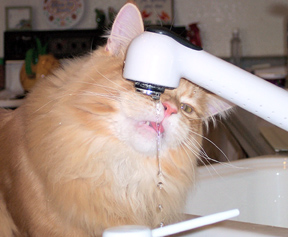
288
You may not be able to get your cat into water, but you need to get water into your cat. Typically, a cat requires about one ounce of water per pound of body weight every day. About 60 percent of a cats body is water, of which about 40 percent is located in the cells. The remainder is in the bloodstream or between the cells. If a cat becomes dehydrated, the blood volume goes down and the cats ability to transmit oxygen and nutrients decreases, says Richard Goldstein, DVM, board certified by the American College of Veterinary Internal Medicine and assistant professor of small animal medicine at Cornell University College of Veterinary Medicine. It only takes a few days for a cat to become dehydrated in normal conditions.
The amount of water your cat needs varies with the amount he exercises, the environmental temperature, and the presence of fever, diarrhea or vomiting. Cats should be replacing all of the water they are losing, says Dr. Goldstein.
Not consuming enough water can spell trouble for your cat. The most immediate problem is acute renal failure, says Dr. Goldstein. A cat also may develop low blood pressure, heat stroke or heart or pancreas damage. Over time, too little intake of water can cause development of bladder stones and urinary tract disease.
Cats with health problems or under extreme conditions need more water than a healthy cat. Any condition that causes excess urination or excess loss through vomiting or diarrhea, hyperthyroidism, kidney failure, diabetes, or being in hot, humid car or unventilated crate requires that a cat intake more water than normal, says Dr. Goldstein.
Your cats water can come from a bowl or from the food he eats. Canned food is more than 70 percent water and supplies some of what your cat requires. Cats fed only dry food need to drink more water than those who are fed moist or canned varieties. Cats fed dry food only have a greater risk of developing urinary tract disease, says Dr. Goldstein.
Some Ideas to Try
Adding water to your cats dry food may help. If you add it slowly each day, cats get used to it, says Dr. Goldstein. You can also add salt to diet to get them to drink, but dont do it unless your veterinarian recommends it for a specific disease.
Cats like water from a variety of sources. Some enjoy drinking from the tap or toilet because the water is cooler. If you use a self-cleaning product in your toilet bowl, make the toilet off-limits for your cats safety. Other cats like water that is room temperature, especially cats that have been strays and accustomed to drinking standing water. For people, drinking water is a way to refresh the tastebuds during meals. Cats dont need to do that, and some cats may prefer to have their water away from their food.
Cats are living longer, says Dr. Goldstein, and the incidence of renal disease is going up so its very important to get your cat to drink. Most cats prefer fresh water, and providing a commercial fountain that circulates the water with an internal pump may encourage a cat to drink more. A larger bowl into which your cat can lower his head without squashing his whiskers may help as well. Some cats paw at their water, possibly to make the surface ripple so they can see it, resulting in litter deposits in the bowl. If your cats water dish develops sediment on the bottom, make sure you change the water often.
Regardless of how you do it, leading your cat to water and encouraging him to drink is vital for his health. If your cat develops bladder stones, look into providing bottled water. Tap water has a high mineral content, says Dr. Goldstein.
If your cat is drinking more or less than he normally does, consult a veterinarian. Changes in drinking habits may be an early sign of a serious medical problem such as diabetes, renal failure or hyperthyroidism.



